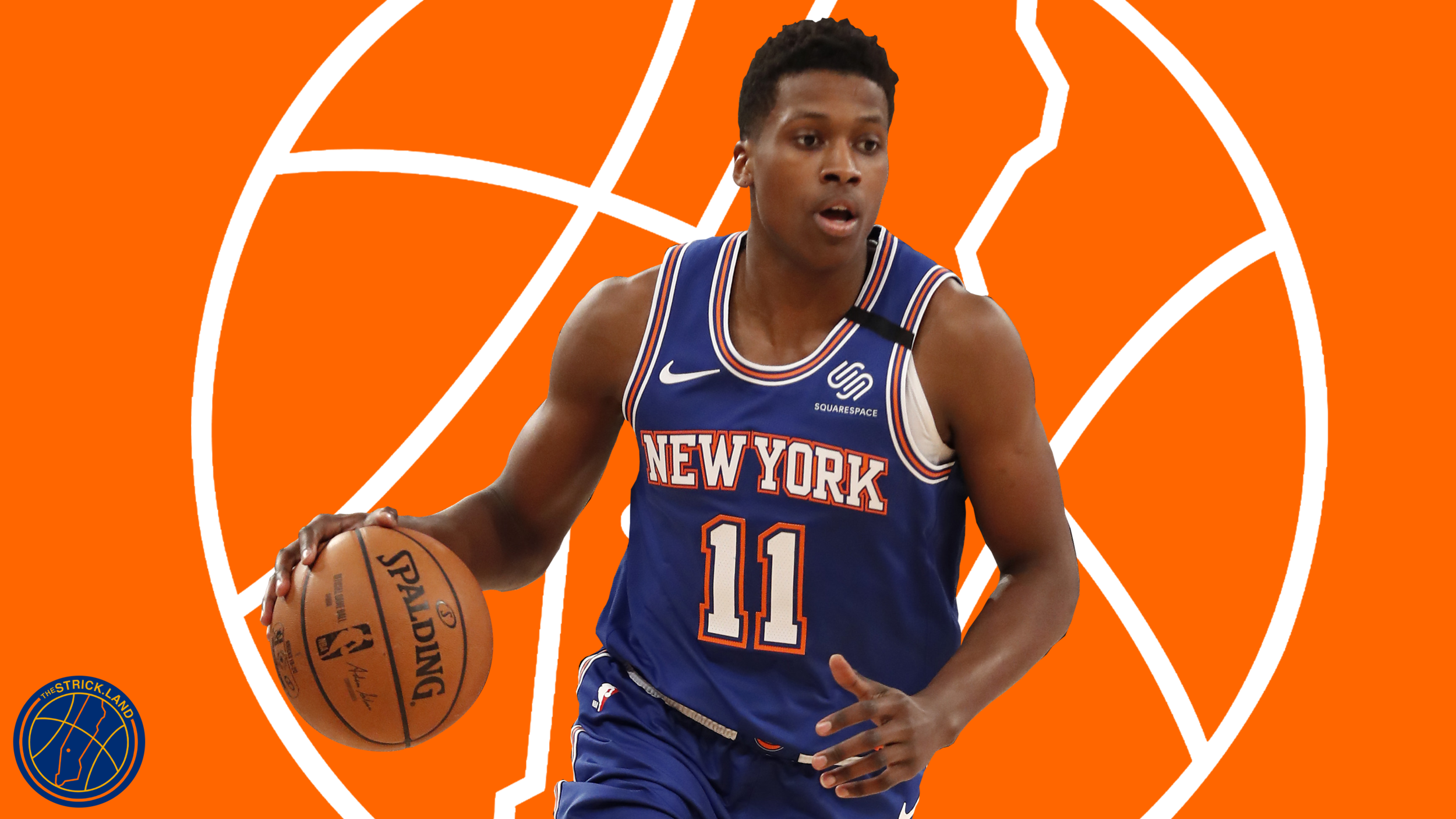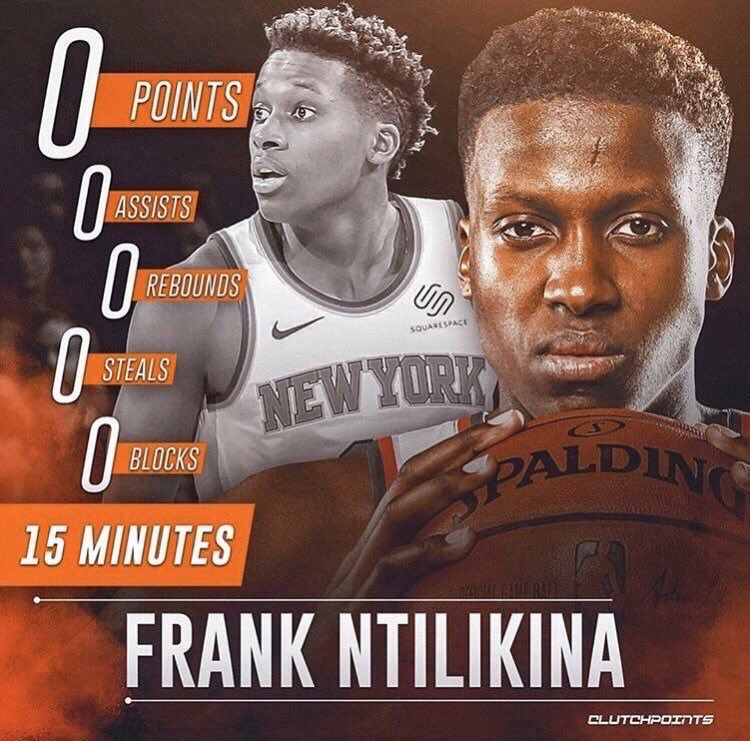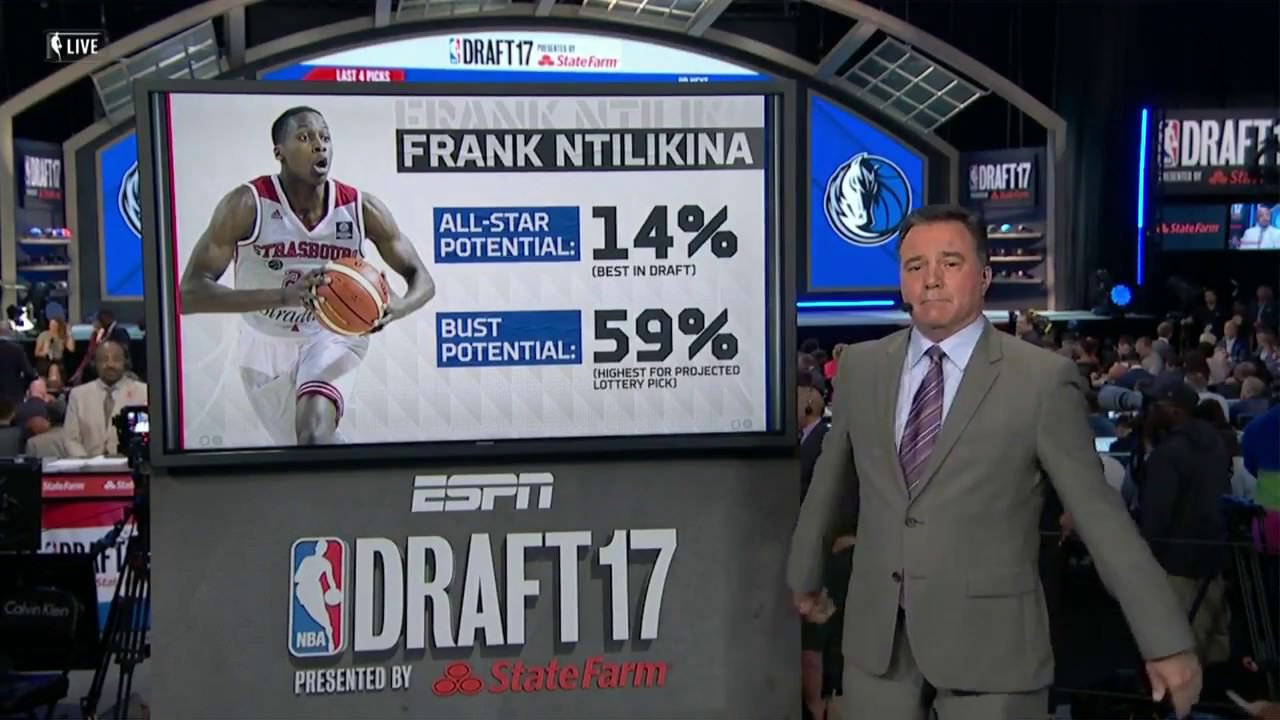A deep dive into the love of Frank Ntilikina, and his value in the present and future
Hello. Welcome. I see you’re here to read a deep dive about Frank Ntilikina. I sincerely respect the decision.
Many people, though, may be confused by it. Frank is entering his fourth season in the NBA, and has never averaged seven points per game in a full season. He’s never shot over 40% from the field; he’s never shot over 33% from three. He’s never averaged over 22 minutes per game, despite playing for three different coaches. He has this unfortunate meme to his name:
He’s had LeBron James, the king of the NBA, come out and near-explicitly say the Knicks made a mistake picking him over Dennis Smith Jr., who couldn’t get off the bench of debatably the worst team in basketball this season.
And hey — most of the country agrees. Courtesy of Google Trends, here’s how the states have searched for each of the two players since February 2019:
Of course, there’s one blue state up there — even though Ntilikina and Smith have been members of the Knicks across the entire time period. I’m from there. I’m willing to bet you are, too.
So, what gives? Why are Knicks fans still so smitten by the curious case of Frank Ntilikina?
The way I see it, there are three reasons.
Reason number one:
I’m not afraid to point it out — I think far cooler kids than myself have called it “drip.”
And it’s not just the chiseled face or the impeccable wardrobe. It’s the way the kid carries himself — living in Europe his whole life, he’s come to the Mecca of basketball (and more importantly, media), and handled it just about perfectly. He’s ready to get buttoned up and say all the right things in a press conference, but at the same time he’s ready to go to war against the aforementioned king of basketball face to face.
Reason number two:
Given the backdrop of his great attitude, Knicks fans just really want Frank to succeed. Through all the memes and all the “bust potential,” he’s an easy kid to root for. The Knicks infamously haven’t extended a rookie since Charlie Ward in 1999, and through all the hate and trade talks, Frank is quietly a leading candidate to break the curse, with only one year left on his rookie deal and a still (for now) orange and blue jersey.
Reason number three:
Man, the kid can really play defense. Something about a lockdown perimeter defender really strikes a chord with Knicks fans, whether they’re tired of defensive sieves like Raymond Felton and Jose Calderon at the point or are simply nostalgic about the good old ‘90s R&B days.
But emotion and storylines aside, just how valuable is Frank?
Let’s start with the obvious: his offense. It… isn’t good. Since his rookie year in 2017, Frank has the single-lowest True Shooting Percentage (45%) of any player in the NBA. And it’s not just a slight edge in the ranking — the difference between his TS% and the third-worst is the same as the difference between the third-worst and the 11th.
For a player to be that inefficient, it takes a whole lot of value provided elsewhere to be a positive player on the court. Think Tony Allen, a generational defender, or young Rajon Rondo, a generational passer. Frank hasn’t shown enough to be super confident in him getting to either of those levels — and it’s not like Allen (career 53% TS) or Rondo (career 50% TS) were quite that inefficient, either. Of course, Frank is still just a neophyte, and was always supposed to be a project, but it’s not unfair to note that whatever offensive jump he may be capable of simply has yet to transpire.
With a statistical assist from Cleaning the Glass, you can see some incremental improvements over his first three seasons if you’re really looking hard for them, but really not a whole lot outside of hitting 86% of his 59 free throws this season (the orange/blue numbers show his percentile rank in that stat relative to his position; blue is bad and orange is good):
It’s not just the shooting that’s concerning, either. He’s also struggled to create in other ways, sporting a poor turnover percentage and actually regressing over his three seasons in assist percentage:
His assist-to-usage ratio is the only bright spot there, but it’s at least partially a function of his incredibly low usage — sixth percentile for a point guard in 2019-20, despite playing in an offense that was extremely short of other offensive talent.
You get the idea. And of course, as always, there’s a ton of context behind the numbers. He’s been in poor situations offensively, and hasn’t ostensibly had coaching — or management — ever really commit to developing his talents.
So, what can really change with a new staff and some personal development? I want to peel the onion a bit more to see if there are any significant spots for optimism.
If we drill down a bit into shot locations, we can see that he hasn’t had success putting the ball in the hoop from… pretty much anywhere:
You’ll notice, though, he actually rained corner threes this past season; 93rd percentile with his 52% clip. Other than layups, these are the most efficient shots in the game; slightly closer than the average 3-pointer.
His 52% number here is at the same time deceiving and encouraging. A tiny sample size (only 27 shots) represents what many high-volume shooters could launch in less than a week. PJ Tucker, for example, got up 238 corner threes this season, hitting 38% of them — no one in their right mind would take Frank over him in a competition.
However, I bring up the Tucker comparison intentionally. After all, why did Frank attempt just 27 corner threes this season? For someone who struggles so much offensively, it seems like a logical first role for him to develop. Stick him in the corner, and let him get them up — it’s not like he’ll be heavily guarded. Frank doesn’t rain from the outside, but it’s not like his shot is broken or anything — he’s got a relatively smooth-looking stroke. Remember, he hit 86% of his free throws this past season, which can be one of the strongest predictors of future long-range shooting success.
He looks pretty damn natural here, looking to shoot immediately off the catch, even with a pass arriving far outside his shooting pocket:
A little bit of flaunting after, too. Talk your talk, Frank.
And how about here — he starts on the wing, cuts perfectly to the corner on the drive, and makes it look smooth:
Of course, you wouldn’t expect any winning franchise to start calling plays to get Frank Ntilikina looks in the corner, but that’s the thing — the Knicks haven’t been a winning franchise. Their goal now should be making sense of their potpourri of young — candidly, meh — prospects, and they simply haven’t done that. Take a look at this shot chart below, courtesy of Ryan Davis. Can you guess the player?
Of course, we’ve already briefly discussed him — PJ Tucker. Specifically, his age-27 season, when he returned to the NBA after six years where he defined the word “journeyman”: from a rookie year in Toronto that didn’t work out, to overseas in Israel one year, Ukraine the next, back to Israel, Greece, Italy, and Germany. That shot chart represents his first year back, and he’s been an NBA staple in the seven years since.
You’ll notice there’s quite a bit of red. Tucker was out of the NBA a while for a reason — he struggled to hit shots. Compare the above chart to the one below:
Frank Ntilikina, 2019-20
Of course, Tucker is a special case. Not everyone who starts out being unable to shoot magically learns. But there’s a lesson to be learned in development here. Tucker was an always-solid defender who put his mind to a single offensive skill — shooting corner threes — and really made it work. Granted, it’s a lot easier when you’re playing off of James Harden as opposed to Dennis Smith Jr., Elfrid Payton, or (shudder) Julius Randle. But that’s kind of the point for the Knicks — it’s really hard to judge young players like Frank when they simply can’t be put in winning situations. Tucker started his shooting development at age 27; Frank is currently 21 with a pretty good looking stroke. This year — the last one on his rookie deal — needs to involve the Knicks prioritizing whether or not Frank can be a contributing, if still well-below average, offensive player.
Why is this so important? His defense truly does have the chance to be special. His high-level indicators are good, outside of fouling (a common problem the past few years for young, defensive-minded Knicks):
However, it’s on a deeper dive where Frank’s unique skills can come to light. I’m not the first to point this out, but he’s been extremely effective at one of the most important skills a guard can have: defending the pick-and-roll. His rookie year, he allowed just 0.63 points per possession in the pick-and-roll, which ranked fourth in the entire NBA. The past two seasons, it hasn’t looked quite as elite, but still great, at 0.83 PPP both years (I think it’s fair to note here his main PnR defense partners have been the likes of Bobby Portis and Julius Randle).
Pick-and-roll defense involves so many little nuances — it’s why the NBA has gravitated so much toward this simple play in recent years. You need to be able to defend in multiple directions, prevent an open pull-up, contain an open drive, and know when and how to switch if needed. A skilled offensive guard who can pass, shoot, and drive off of a screen is nearly impossible to stop, making players who can do those things — and players who can stop them — hugely valuable.
Here’s one of my favorites. He’s guarding Dame Lillard in the half court, and Reggie Bullock obviously needs to push up to prevent the three. Frank floats around like a heat-seeking missile, seemingly knowing exactly how the play will develop. He switches onto the screener, then fronts him as the second pass is being thrown, cutting it off the steal:
What about here, matched up against playoff superstar Jamal Murray? Frank balances playing it safe (he goes under the screen) with ball pressure (he can use his huge wingspan to recover quickly), and capitalizes on the slightest hesitation to steal some cookies and take them all the way home:
Here’s a neat little trick he does. Frank wraps around the screen to contain the guard to the outside, but anticipates the pass with his long arms, knowing what will happen when Taj Gibson cuts off the drive:
And a similar example from a different game, also working with Taj. Cory Joseph makes a quick drive, but Frank effortlessly avoids the screen, allowing him to get into perfect position to again cut off the dish he knows is imminent:
Defense shouldn’t just be measured by individual steals, and blocks, though, of course. Impactful defenders affect the success of the entire five-man unit, and Frank has shown that ability. Again from Cleaning the Glass, here’s the difference between some of the Knicks’ defensive metrics when he’s on vs. off the court:
It’s not like there are hundreds across the board, but it’s a clear positive impact — opponents get fewer points per possession, shoot a lower effective field goal percentage, and turn the ball over significantly more when Frank is on the court than when he’s not.
And the thing is, the Knicks have been better as a team in general when he’s on the court; not just defensively. All three seasons, even going back to a 19-year old rookie, Frank’s on/off has been above average for his position; this past year providing a differential equivalent to six extra Knick wins over an 82-game season:
This is pretty remarkable to see, considering just how bad his offense has been. Of course, it’s partially because his replacements have been bad as well; coming in for Elfrid Payton and Dennis Smith Jr. is a golden opportunity to provide a positive differential. But this should be self-evident to the Knicks coaches — with the way the roster is currently constructed, Frank should be the guy on the court more often than not, and not just for the sake of his future development.
So what’s the next step for Frank and the Knicks? He’s already being floated in more trade talks, e.g. for Chris Paul. I don’t think such a trade would be a disaster, as many Knicks fans are making it out to be (Chris Paul is a literal All-NBA player, even at 35), but it still would be disappointing to see the Knicks give up on yet another young project, after both knowing he was a project and failing to do him justice with any semblance of development effort.
The fact is, time is running out, whether he’s traded or not. Frank has one year left on his rookie deal, and in the short term, he’s likely to be a positive piece, per Jacob Goldstein’s absolutely incredible player projection tool, which runs on his advanced impact metric PIPM (player impact plus-minus):
Further down the line, Goldstein’s model doesn’t see Frank as a star, and a meteoric rise is still unlikely, but improvement is expected:
For context, players with around 2.3 Wins Added this past season included Josh Richardson and Norman Powell. Russell Westbrook, who the Knicks definitely should not trade for, was a 3.07.
If the Knicks were to extend Frank, the model sees a break-even five-year number of $50.1 million; around $10 million per year:
How comfortable would I feel locking up Frank long-term with real money? As always, it depends. It’s unfortunate to put so many eggs in the basket of this upcoming season, but that’s really (to an extent) what we have to do. In the way of growth as a player over his first three seasons, Frank has shown very little, and although a significant chunk of that blame falls on the failure of coaches and management, it’s frankly (ha) fair to wonder how much of it falls on him. There’s a very real chance that even if there are incremental improvements, he will always be a significant negative on offense without ever becoming that All-NBA type of defender that he has shown flashes of. But if Bobby Portis can get $15 million a year from the Knicks, why not a 22-year-old Vogue model who can stand up to LeBron and put the clamps on Luka? Sure, Frank won’t be the next Giannis, but that doesn’t make me any less interested in what his young career has in store.
With that, one more drip pic for the road:


















